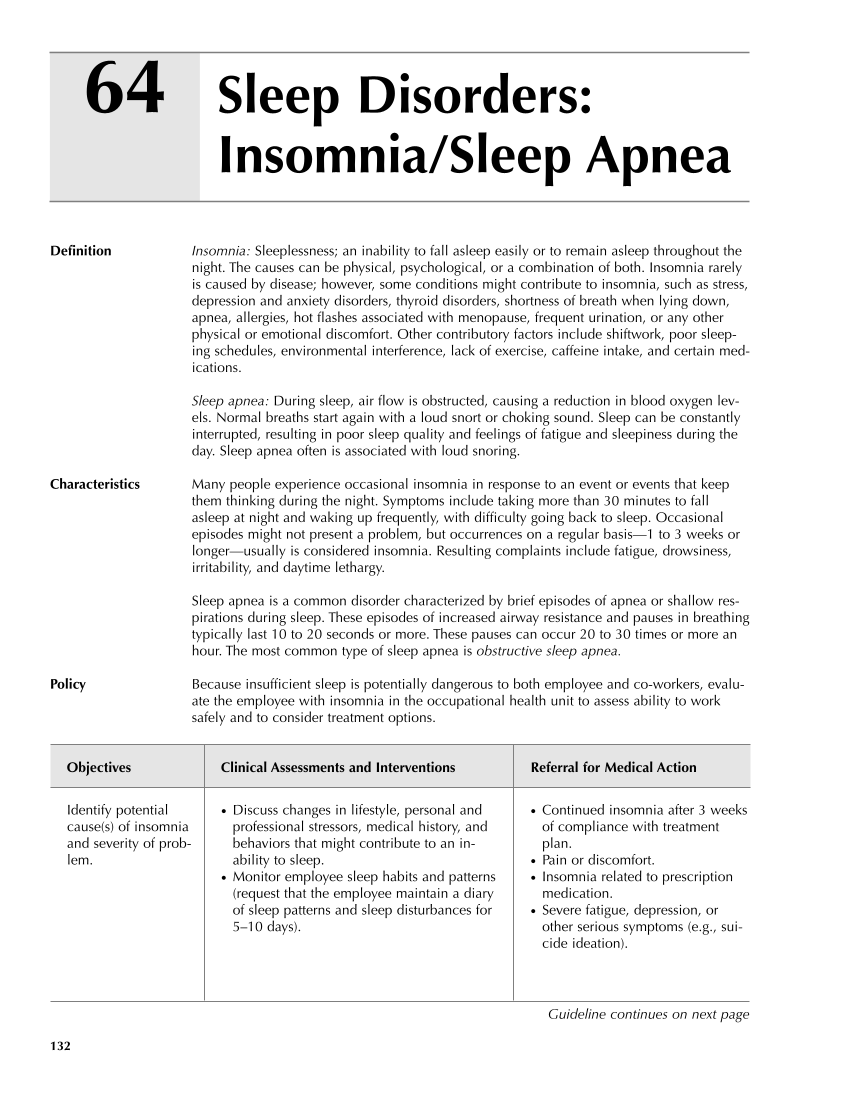132 64 Definition Insomnia: Sleeplessness an inability to fall asleep easily or to remain asleep throughout the night. The causes can be physical, psychological, or a combination of both. Insomnia rarely is caused by disease however, some conditions might contribute to insomnia, such as stress, depression and anxiety disorders, thyroid disorders, shortness of breath when lying down, apnea, allergies, hot flashes associated with menopause, frequent urination, or any other physical or emotional discomfort. Other contributory factors include shiftwork, poor sleep- ing schedules, environmental interference, lack of exercise, caffeine intake, and certain med- ications. Sleep apnea: During sleep, air flow is obstructed, causing a reduction in blood oxygen lev- els. Normal breaths start again with a loud snort or choking sound. Sleep can be constantly interrupted, resulting in poor sleep quality and feelings of fatigue and sleepiness during the day. Sleep apnea often is associated with loud snoring. Characteristics Many people experience occasional insomnia in response to an event or events that keep them thinking during the night. Symptoms include taking more than 30 minutes to fall asleep at night and waking up frequently, with difficulty going back to sleep. Occasional episodes might not present a problem, but occurrences on a regular basis—1 to 3 weeks or longer—usually is considered insomnia. Resulting complaints include fatigue, drowsiness, irritability, and daytime lethargy. Sleep apnea is a common disorder characterized by brief episodes of apnea or shallow res- pirations during sleep. These episodes of increased airway resistance and pauses in breathing typically last 10 to 20 seconds or more. These pauses can occur 20 to 30 times or more an hour. The most common type of sleep apnea is obstructive sleep apnea. Policy Because insufficient sleep is potentially dangerous to both employee and co-workers, evalu- ate the employee with insomnia in the occupational health unit to assess ability to work safely and to consider treatment options. Objectives Clinical Assessments and Interventions Referral for Medical Action Sleep Disorders: Insomnia/Sleep Apnea ● Continued insomnia after 3 weeks of compliance with treatment plan. ● Pain or discomfort. ● Insomnia related to prescription medication. ● Severe fatigue, depression, or other serious symptoms (e.g., sui- cide ideation). Identify potential cause(s) of insomnia and severity of prob- lem. ● Discuss changes in lifestyle, personal and professional stressors, medical history, and behaviors that might contribute to an in- ability to sleep. ● Monitor employee sleep habits and patterns (request that the employee maintain a diary of sleep patterns and sleep disturbances for 5–10 days). Guideline continues on next page
Purchased from OEM Press by (ge corporate access). (C) 2013 OEM Health Information, Inc. All rights reserved.












































































































































































































































































































































































































































